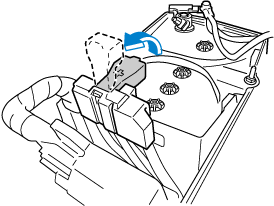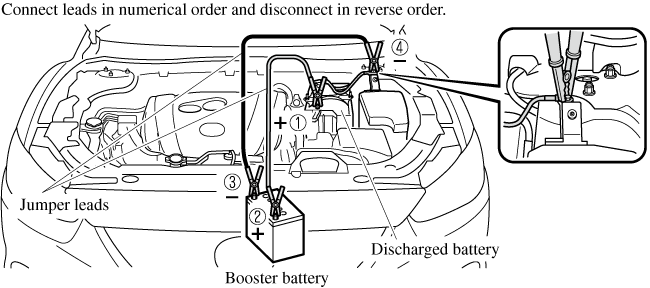

Jump-Starting
Jump-starting is dangerous if done incorrectly. So follow the procedure carefully. If you feel unsure about jump-starting, we strongly recommend that you have a competent service technician do the work.
 Follow These Precautions Carefully:
Follow These Precautions Carefully:
To ensure safe and correct handling of the battery, read the following precautions carefully before using the battery or inspecting it.
 Keep flames and sparks away from open battery cells and do not allow metal tools to contact the positive (
Keep flames and sparks away from open battery cells and do not allow metal tools to contact the positive ( ) or negative (
) or negative ( ) terminal of the battery when working near a battery. Do not allow the positive (
) terminal of the battery when working near a battery. Do not allow the positive ( ) terminal to contact the vehicle body:
) terminal to contact the vehicle body:
Flames and sparks near open battery cells are dangerous. Hydrogen gas, produced during normal battery operation, could ignite and cause the battery to explode. An exploding battery can cause serious burns and injuries. Keep all flames including cigarettes and sparks away from open battery cells.
 Keep all flames and sparks away from open battery cells because hydrogen gas is produced from open battery cells while charging the battery or adding battery fluid:
Keep all flames and sparks away from open battery cells because hydrogen gas is produced from open battery cells while charging the battery or adding battery fluid:
Flames and sparks near open battery cells are dangerous. Hydrogen gas, produced during normal battery operation, could ignite and cause the battery to explode. An exploding battery can cause serious burns and injuries. Keep all flames including cigarettes and sparks away from open battery cells.
Do not jump-start a frozen battery or one with a low fluid level:
Jump-starting a frozen battery or one with a low fluid level is dangerous. It may rupture or explode, causing serious injury.
Connect the negative lead to a good ground point away from the battery:
Connecting the end of the second jumper lead to the negative ( ) terminal of the discharged battery is dangerous.
) terminal of the discharged battery is dangerous.
A spark could cause the gas around the battery to explode and injure someone.
Route the jumper leads away from parts that will be moving:
Connecting a jumper lead near or to moving parts (cooling fans, belts) is dangerous. The lead could get caught when the engine starts and cause serious injury.
Use only a 12 V booster system. You can damage a 12 V starter, ignition system, and other electrical parts beyond repair with a 24 V power supply (two 12 V batteries in series or a 24 V motor generator set).
-
Move the booster vehicle so that its battery is as close as possible to your vehicle's battery.
-
Make sure that the power such as for the headlights and air conditioner is turned off.
-
Remove the battery cover.

-
Turn off the booster vehicle's engine and connect the jumper leads in the following order.
Make sure that the jumper leads are securely connected so that they do not disconnect due to engine vibrations.
1st lead
-
Positive (+) terminal on the discharged battery
-
Positive (+) terminal on booster vehicle's battery
2nd lead
-
Negative (-) terminal on booster vehicle's battery
-
Location shown in the figure (do not connect to the negative (-) terminal of the battery)

-
-
Start the booster vehicle's engine and rev the engine.
-
Start the engine of your vehicle. Run the engines for about 3 minutes to temporarily charge the battery of your vehicle.
-
(Vehicles with i-ELOOP)
The i-ELOOP charging indication message may display in the instrument cluster after the engine is started. The message is no longer displayed when the engine is running and the charging is completed. Make sure that the message is no longer displayed.

If the vehicle is driven while the message is displayed, a sound is activated. If you turn the steering wheel while the message is displayed, it will feel heavier than normal, but this does not indicate a problem. The steering operation will return to normal after the message has disappeared.
Do not disconnect the jumper leads while the message is displayed.
-
Disconnect the jumper leads in the reverse order of their connection.
-
Install the battery cover.
-
Have your vehicle inspected by an expert repairer, we recommend an Authorised Mazda Repairer as soon as possible.




